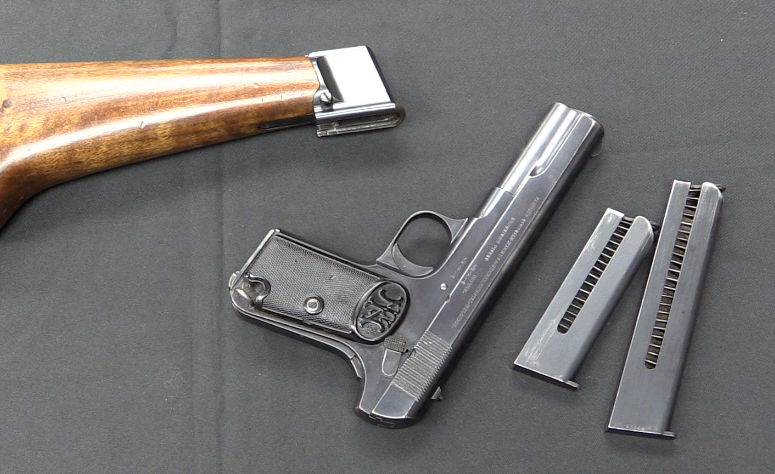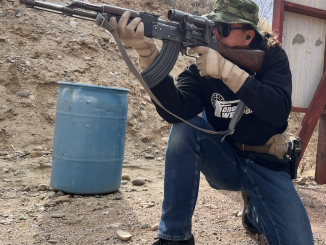As World War Two developed, the Soviet Union found that bayonets were frequently lost from its M91/30 Mosin Nagant rifles. The standard bayonet, as adopted all the way back in 1891, was a long spike attached via socket over the muzzle. Carried on the belt is was long and awkward and easily discarded, and fixed to the rifle it made an already long weapon even less mobile.
In an effort to find a solution, a selection of folding bayonets were investigated, which the best design coming form one N.S. Semin. His bayonet would ultimately be adopted as part of the M44 Carbine, but before that happened it was also tested on M91/30 long rifles. Where the M44 used a permanently attached type, the version trialed on the M91/30 used a similar socket to the original bayonet, albeit with an addition locking pin to keep it in place. Testing began in the summer of 1943, and ultimately 11,500 were made by the end of that year and another 10,000 in early 1944. They were used in active fighting, but by the spring of 1944 the M91/30 was slated to be replaced entirely by the M44 carbine and further production of the long folding bayonet ceased.
A few years ago a small batch (about 100 guns) of these rifles was located, having been refurbished and put into storage after the war. They were imported into Canada, where an anonymous collector was kind enough to give me access to film this one.




At one point in my firearms collecting life I owned a short barreled sks rifle with what I remember to be this, or a very similar bayonet, same manufacturer? or just a copy of a workable and proven design?
“(…)sks(…)”
According to https://ru.wikipedia.org/wiki/%D0%A0%D1%83%D1%81%D1%81%D0%BA%D0%B8%D0%B9_%D1%87%D0%B5%D1%82%D1%8B%D1%80%D1%91%D1%85%D0%B3%D1%80%D0%B0%D0%BD%D0%BD%D1%8B%D0%B9_%D0%B8%D0%B3%D0%BE%D0%BB%D1%8C%D1%87%D0%B0%D1%82%D1%8B%D0%B9_%D1%88%D1%82%D1%8B%D0%BA
Игольчатый четырёхгранный штык неотъёмный, складной, был в комплекте самозарядного карабина Симонова, образца 1945 года, хотя вскоре после начала производства, был заменён на ножевидный.
that is:
Needle fouredge bayonet non-detachable, folding was part of self-loading carbine of Simonov, pattern 1945 year, however soon after production began, was replaced by knife-like.
Probably manufactured by the same factory that produced the rifle. The name is from the designer, not the maker. Not to mention, the short barrel SKS is probably a Chinese rifle. Three types on SKS’s, IIRC, one very similar with the loop over the barrel, one with that loop ground at an angle to allow the barrel to help cam the bayo against the spring, and one with a diagonal cut locking lug instead of a loop, for Yugo guns with a grenade launcher/flash hider unit. Not to mention blades vs spikes.
The Chinese type 53 is a licensed copy of the m44 with the same bayonet. I had a few of them back in the late 80s I think when they were going for $50 each. One of them had some folded up Chinese money under the butt plate.Fun little carbines if you like excessive recoil and huge flames.
Terence W. Lapin’s book The Mosin-Nagant Rifle lists a few experimental folding bayonet designs for the MN rifle. One similar to the bayonet shown in your video is the Gulkevitch Experimental Model (c. 1912) Overall length: 510mm: Blade length: 425mm: Blade width: 17mm: Interior diameter of the socket: 15mm: Socket length (in battle position): 81.8mm.
I think (memory trust issue alert!) that, at least during WWI, the Russian army issued NO bayonet scabbard. The looong toothpick bayonet was supposed to stay permanently fixed on the loooong rifle.
The Soviet M1891-30 7.62x54R-mm rifle was supposed to have the socket bayonet permanently affixed, with the exceptions being while in barracks, or traveling by wagon, or aboard a train, or aboard a truck, and a few similar instances. That way, the rifle was ready for instant use as a spear, or a club, or as a repeating rifle with a slow-rate of fire.
According to Ukrainian researcher and author Alexander Yushenko:
https://www.m9130.info/models-guide
There were 19.5k such prototypes made and issued for troops trials, before the Semin-designed folding bayonet was applied to the M38 carbine and–hey! presto!–the M44 service rifle/ carbine was born. Truly the “last bolt action rifle” in which an 1891 first-generation bolt-action rifle design–namely, the Mosin-Nagant action–was wedded to a too-short-by-far-for-the-cartridge barrel, and a folding bayonet of a type that would not have been out of place on a blunderbuss intended to deter highwaymen in the late 18th-early 19th centuries. This carbine, in turn, was then manufactured by the Soviets in huge quantities until 1948, served as something approaching a standard pattern rifle for the KPA in the Korean War, and even by war’s end for the Chi-com PLA, showed up in Vietnam, was manufactured in Poland, Romania, Hungary, and then dumped on any number of National Liberation Movements in Asia and Africa… Vietnam… Portuguese Africa… Afghanistan… you name it.
Despite the many interesting and under-appreciated industrial achievements of the USSR in WWII–or the GPW if you prefer–so, for example, the T70 light tank has to remain in production for a time, because not enough industrial capacity exists–at least yet–to switch over to the T-34, at least it can have a 45-mm AT gun and “punch above its weight” unlike kindred “coffins for two brothers” that it superseded, etc. etc.–the wastage rate for the silly bayonet issued without a scabbard, or a flimsy canvas hanger to substitute for one, has got to rate as one of the biggest wastes of steel in wartime during WWII? I mean, how many people operating in the rubble of towns and cities, or in the dense forests, simply ditched the largely useless things, content in the knowledge that when things turned physical with the Hitlerites, their allies, their collaborators and polizei, etc. etc. a sharpened shovel or “finnka” knife would be far handier and more practical than the musket-era socket bayonet?
Granted, bayonet training is mostly about rehearsing aggression and a desire to close with the enemy, but surely all that wasted metal could have been turned into lord knows how many extra PPSh41 or PPS43 SMGs or RG-42 hand grenades?
At least with the French MAS Mle. 1936 fusil de repeticion, the bayonet came completely away from the rifle and could be used for something useful like probing for non-metallic land mines… With the Soviet example? Not so much. Maybe it helped soldat Ivan lever open locked doors and cellars and the like…
Note how the bayonet disappeared: Apparently, first Austria’s Bundesheer dispensed with the things with the Stg. 58 FAL, and kept them off with the AUG. Not the Brits though. The bayonet goes on the Sten Mk.V, the Sterling SMG, the IW/SA80 in all its iterations–they even brag about using it in the “sandbox” as stand in for the 19th C. Charge of the Light Brigade–and on and on and on. The Chinese went from the knife bladed SKS Type 56 back to the spike version in 1965, but those rifles have been relegated to U.S. civilians and Bangladesh by now… The Soviets made up for the spike bayonet by producing a Kalashnikov version that doubled as a pair of wire cutters, which was mighty smart. It might have been more worthwhile to produce a pair of wire cutters that could double as a melée weapon!
I used the one that came with my M91/30 to open a bottle of Czech beer once. The tip is flat and could be used as a screwdriver. Also I’d bet it’d make a handy roasting split for something like a hotdog or small piece of meat, maybe a whole chicken?
Are there any reports of decisive bajonet use by Soviet/Chinese troops in combat? Several German soldiers who had served on the Eastern Front told me that the rifle butt and the entrenching tool dominated close-in man-to-man encounters. Accordinmg to them, neither German nor Soviet bajonets were of any significance.
The German machinegunner who was one of my primary informants on German machinegun practice put it about like this: “If you let a Communist Russian with a bayonet close enough to let him use it on you, you’re not going to live through it…”.
This is one of those issues where I’m profoundly suspicious of the published statistics, which are usually gathered up through medical channels. Nobody is out there poking and prodding through the piles of dead bodies to do autopsies, so all we get for data comes from the guys who were wounded, and if you’re the subject of a bayonet attack, you’re not bloodly likely to be “lightly wounded” in the course of that. More likely is that your bayonet-wielding assailant is going to be in a state that’s conducive to them turning your body into a pincushion with that nice poky bit on the end of their rifles. It will be even uglier if you turn and run.
You want to get solid stats on this stuff, you’re pretty much going to have to go back through those mass graves that the bodies got tipped into, and do some analysis of what killed the men that went into them, if you can do so at this late date. My guess is that the number of “dead by bayonet” numbers are going to be considerably higher than the ones we have now for guys who made it back into the medical channels.
The data on all of this is seriously suspect, and when you go back to look at how it was derived, you find yourself beginning to wonder what, if anything, can be trusted.
There’s also the psychological factor to consider: Say you are a German soldier who suddenly discovers that there are a bunch of crazy Soviets with bayonets in your area. How do you react? Do you stick around for the bayonet-frenzy, or do you unass your location for somewhere else, and get killed by artillery/MG fire/mortars/tanks? How should that kill be attributed, by responsibility? If fear of the bayonet put you out in the open field behind your initial position, and the nice artilleryman dropped a barrage on your ass, who should get the credit?
The whole question of trying to determine whether weapon “A” is “more effective” than weapon “B” is fraught with uncertainties and undefinable indeterminates. Sure, the bayonet may be unbloodied, but did it make the kill possible or not? That’s the question, and the answer may or may not be something we can determine from our nice comfy chairs at this late date.
Bayonets are for stabbing the wounded to death. So you are right, in a sense, that no one shows up at the field hospital wounded by a bayonet. Not any evidence that they actually “killed” enemy soldiers–unaided or not preceded by another wound caused by one or another agent.
For armies, erm, uh, “fixated?” on the bayonet, I’m sure NCOs and officers expected to see some gore on the bayonet of the soldiers… Certainly Antonio López de Santa Anna was insistent that the arms all be in good condition “especially the bayonets” before dawn on 6 Mar. 1836….
There are anecdotes of Germans in WWI trying to surrender after rehearsing Omdurman or some other mass technified slaughter against Australian “diggers” being bayoneted by Aussies. Also, during the Meuse-Argonne, German machine gun teams with MG08/15s dispersed in a decentralized pattern ahead of the regular Sigfried Stellung, aka. “Hindenburg Line” would fire literally every single cartridge and belt at their disposal at attacking Americans. Once out of ammo, they’d stand up, hands raised, and say something like “Kamerad!” only to be bayoneted to death by surviving American infantry. Not that any of those things makes the bayonet an effective weapon, apart from instilling bellicosity and belligerence and the obsession about “closing with the enemy.”
“(…) Accordinmg to them, neither German nor Soviet bajonets (…)”
I want to note that ГАУ (Main Artillery Directoriate) during Great Patriotic War hold view that bayonet are not necessary for sub-machine guns and thus turned down requests to add one to PPSh, on the other hand with high pressure on arms factories, to produce arms for Soviet-German front, naval factory number 202 (Vladivostok) produced own version of PPD:
https://www.kalashnikov.ru/s-ochen-dalyokogo-zavoda-pistolet-pulemyot-ppd-40/
they decided in PPD rather than PPSh, as not requiring presses, but it was greatly simplified – among other it was full-auto only, yet it did accepted knife bayonet (as used in SVT-40), despite basic PPD did not.
Interesting video. I wonder how hard it would be to make this now? Considering how many Mosin’s we have in North America there might be an aftermarket for this (I would want one, new or original)
The 4-sided bayonet itself was taken from an Italian rifle when it turned out that the old 3-sided bayonet on the Berdan rifle causes bullet deflection.
The folding unit was taken from an Italian carbine.
During WW1 (at its beginning), bayonets were used relatively frequently. But later, due to a drop in the level of training of soldiers, his role decreased significantly and was used mainly as a dagger. And the rifle itself, in hand-to-hand combat, Russian soldiers used as a club.
A similar story, almost exactly, was repeated in WW2.
A modern Russian bayonet for AK74, it’s just a piece of crap that is good for nothing but pure bayonet use. With the same success, they could adapt a piece of building reinforcement.
By the way, they did just that in Afghanistan. 😉
Pardon, perhaps the American bayonet is more likely.
https://picclick.com/Remington-Manufacture-M1867-Swedish-Remington-Rolling-Block-12mm-324108500224.html
I have often wondered why the Soviets never produced a universal rifle with a 24″ barrel, when almost every other great power did.
The original 1891 had a 31″ barrel, reduced to 28″ in the 1891/30, and the carbine had a 20″ barrel. It seems like a needless complication to have kept two separate types when the universal rifle concept was well established.
I can see why the 20″ carbine was liked for its handiness as compared to the 28″ rifle, but it cannot have been much fun to shoot with 7.62x54mm ammunition. On the other hand, if it had been chambered for the 7.62x39mm, then the 1944 carbine would have been a very nice weapon indeed, especially if they had bothered to turn down that bolt handle as well. I think the long suffering Russian soldier would have appreciated such a carbine, which could have been in production at least a year before the SKS, in time to fight in the battles of the last year of the war.
“(…)have kept two separate types(…)”
Yes two different types, but having numerous parts in common – so armorers could easily repair both versions, without needing two completely separate sets of tools.
“(…)if it had been chambered for the 7.62x39mm(…)”
Then lesser would be common – different equipment for chamber checking would be required. In Soviet Union 7,62 x 39 mm repeating rifle was tested soon after Great Patriotic War – see 41-1 xor 41-2 here: http://www.earmi.it/armi/atlas2/602.htm
but it did not get beyond prototype stage.
Daweo:
Thanks for that interesting information.
It seems the Russians did experiment with a 7.62x39mm Mosin carbine, but not in time for the war. A shame, as it would have been a very nice weapon for the Russian soldier if it had been available in time. Obviously, it would have been a stop gap until the SKS was ready, but there is no reason I can see why they could not have done it if the will was there. And I still do not see why the Russians did not adopt a 24″ universal rifle when they had the chance. That was a real mistake on their part, in my opinion.
Friend of mine got one of those 100 rifles — surprised me with it the other day when he showed it to me.